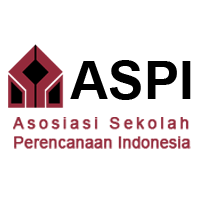STUDI PENGEMBANGAN EKONOMI LOKAL TERKAIT INTERAKSI DESA-KOTA
Studi Kasus: Kawasan Sentra Airguci, Kabupaten Banjar
DOI:
https://doi.org/10.29313/jpwk.v14i1.276Keywords:
Development, Local Economy, InteractionAbstract
Study of Local Economic Development (LED) in Banjar district is determined from the determination Spatial Plans (RTRW) Banjar district regarding domestic Airguci handicraft industry which is in East Martapura Sub-district, precisely in the Mekar Village and the Melayu Ulu Village. This study starts from the initial assumption that there is no balance in the construction planning for urban and rural areas. The purpose of this study are: first, to develop the local economy Airguci craft based on the potential problems, opportunities and threats in order to improve the economy of rural communities, both improving the relationship of mutual support (interaction) between villages and cities in an effort to reduce the inequality between regions. The research method uses a combination of approaches, methods of qualitative and quantitative methods. Source of data derived from primary and secondary survey. Data collection techniques performed through questionnaires, interviews, observation and documentation. Data were analyzed using analysis of Diamond Porter, SWOT analysis, and analysis of the gravity of the rural-urban interactions. The results showed that the implementation of LED in the Airguci centers undeveloped and still is as a sideline activity. People especially women are actively involved in this business activity. But unfortunately, see the existing condition in the Airguci centers are not supported by good infrastructure such as roads and institutions that have not been running for the establishment of a business group that Airguci craft business activities can continue to survive. So many women who have been married, moved to the outside of the village. There are still many who choose to work in the city. Factors to be driving at the same obstacle in the implementation of the LED Airguci centers include: human resources, capital, marketing and institutional. The economic impact of the implementation of the LED in the Airguci centers, namely the local communities to help increase revenue and reduction in unemployment has not yet arrived when the harvest season.
References
Bintarto, R. 1983. Interaksi Desa-Kota dengan Permasalahannya. Jakarta: Ghalia Indonesia.
Blakely. 1990. Planning Local Economic Development: Theory and Practice, New Delhi: Sage Publications.
Carrothers, G. P. 1956. “A Historical Review of the Gravity and PotentialConcepts of Human Interaction” dalam Journal of the American Institute of Planners.
DJ, Kurniawan dan Novar Anang Pandria. 2008. Pengaruh PergerakanPenduduk Terhadap Keterkaitan Desa-Kota di Kecamatan Karangawen dan Kecamatan Grobogan. Tugas Akhir. Semarang: Program S1 Jurusan Perencanaan Wilayah dan Kota Fakultas Teknik Universitas Diponegoro.
FAO. 1995. Planning for Sustainable Use of Land Resources: Towards a New Approach. Rome: FAO Land and Water Bulletin.
Hair, J. F., R. E. Anderson, R. L. Tatham, & W. C. Black. 1995. Multivariate Data Analysis. Edisi Keempat. New Jersey:Prentice Hall.
Handayani, Wenny. 2008. Usaha Kerajinan Airguci “Berkat Sabar” Pemberdayaan Pengrajin Airguci Desa Keliling Benteng Tengah Kalimantan Selatan Tahun 1996-2005. Skripsi. Banjarbaru: Program S1 FKIP UNLAM.
IHS, 2006 Concept of Local Economic Development, Course Material of LED, Rotterdam.
Makmur. 2010. Pengembangan Ekonomi Lokal.https://panritacikal.wordpress.com/2010/10/30/konsep-pengembanganekonomi-lokal-pel/comment-page-1/#comment-326. Diunduh tanggal 1 Januari.
Moleong, Lexy J. 2007. Metodologi Penelitian Kualitatif. Bandung: Remaja Rosda Karya.















